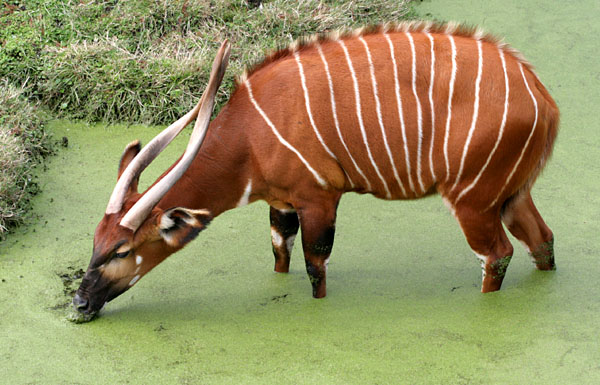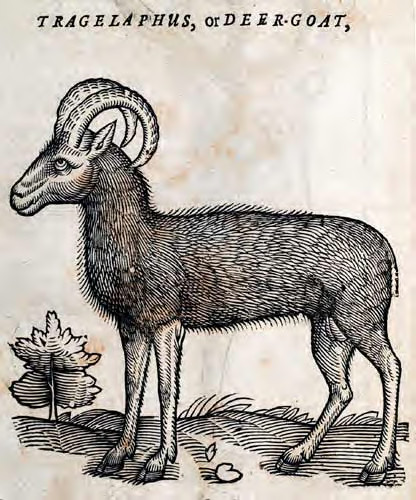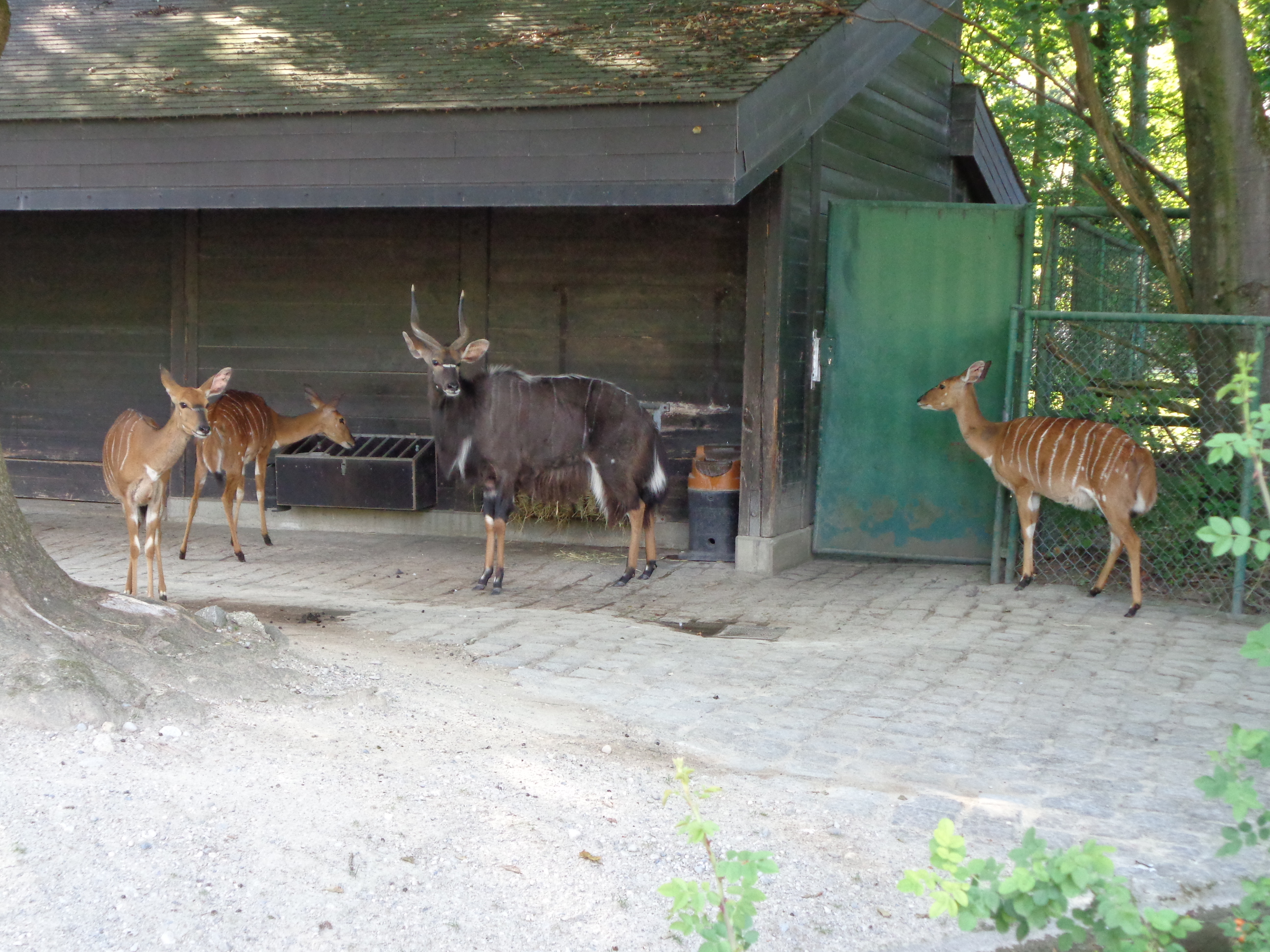|
Tragelaphus
''Tragelaphus'' is a genus of medium- to large-sized, spiral-horned antelopes. It contains several species of bovines, all of which are relatively antelope-like. Species in this genus tend to be large in size and lightly built, and have long necks and considerable sexual dimorphism. Elands, including the common eland (''Taurotragus oryx''), are embedded within this genus, meaning that ''Taurotragus'' must be subsumed into ''Tragelaphus'' to avoid paraphyly. Alternatively, ''Taurotragus'' could be maintained as a separate genus, if the nyala and the lesser kudu are relocated to their own monospecific genera, respectively ''Nyala'' and ''Ammelaphus''. Other generic synonyms include ''Strepsiceros'' (which applies to ''T. strepsiceros'') and ''Boocercus'' (for ''T. eurycerus''). The name "Tragelaphus" comes from the mythical tragelaph. Taxonomy and phylogeny ''Tragelaphus'' is a genus in the tribe Tragelaphini and the family Bovidae. The genus authority is French zoologist Henr ... [...More Info...] [...Related Items...] OR: [Wikipedia] [Google] [Baidu] |
Tragelaphini
The tribe Tragelaphini (sometimes referred to by some authors as "Strepsicerotini"), or the spiral-horned antelopes, are bovines that are endemic to sub- Sahara Africa. These include the bushbuck, kudus, and the elands. The scientific name is in reference to the mythical creature the tragelaph, a Chimera with the body of a stag and the head of a goat. They are medium-to-large, tall, long-legged antelopes characterized by their iconic twisted horns and striking pelage coloration patterns (most common is the distinctive white, vertical barring). Despite being among the largest species of antelope, they are actually more closely related to cattle (''Bos taurus''), and together along with a few apparent Asiatic species belong to the subfamily Bovinae. While the group's evolutionary history occurred in Africa, there have been fossil species that have been found in Eurasia (which may also be the place of origin for this group). The number of genus, genera and species is debated as som ... [...More Info...] [...Related Items...] OR: [Wikipedia] [Google] [Baidu] |
Nyala
The lowland nyala or simply nyala (''Tragelaphus angasii'') is a spiral-horned antelope native to southern Africa. It is a species of the family Bovidae and genus ''Tragelaphus'', previously placed in genus ''Nyala''. It was first described in 1849 by George French Angas. The body length is , and it weighs . The coat is maroon or rufous brown in females and juveniles, but grows a dark brown or slate grey, often tinged with blue, in adult males. Females and young males have ten or more white stripes on their sides. Only males have horns, long and yellow-tipped. It exhibits the highest sexual dimorphism among the spiral-horned antelopes. It is not to be confused with the endangered mountain nyala living in the Bale region of Ethiopia). The nyala is mainly active in the early morning and the late afternoon. It generally browses during the day if temperatures are and during the night in the rainy season. As a herbivore, the nyala feeds upon foliage, fruits and grasses, and requir ... [...More Info...] [...Related Items...] OR: [Wikipedia] [Google] [Baidu] |
Tragelaphus Angasii
The lowland nyala or simply nyala (''Tragelaphus angasii'') is a spiral-horned antelope native to southern Africa. It is a species of the family Bovidae and genus ''Tragelaphus'', previously placed in genus ''Nyala''. It was first described in 1849 by George French Angas. The body length is , and it weighs . The coat is maroon or rufous brown in females and juveniles, but grows a dark brown or slate grey, often tinged with blue, in adult males. Females and young males have ten or more white stripes on their sides. Only males have horns, long and yellow-tipped. It exhibits the highest sexual dimorphism among the spiral-horned antelopes. It is not to be confused with the endangered mountain nyala living in the Bale region of Ethiopia). The nyala is mainly active in the early morning and the late afternoon. It generally browses during the day if temperatures are and during the night in the rainy season. As a herbivore, the nyala feeds upon foliage, fruits and grasses, and requir ... [...More Info...] [...Related Items...] OR: [Wikipedia] [Google] [Baidu] |
Tragelaphus Buxtoni
The mountain nyala (Amharic: የተራራ ኒዮላ) (''Tragelaphus buxtoni'') or balbok is an antelope found in high altitude woodland in a small part of central Ethiopia. It is a monotypic species (without any identified subspecies) first described by English naturalist Richard Lydekker in 1910. The males are typically tall while females stand at the shoulder. Males weigh and females weigh . The coat is grey to brown, marked with two to five poorly defined white strips extending from the back to the underside, and a row of six to ten white spots. White markings are present on the face, throat and legs as well. Males have a short dark erect crest, about high, running along the middle of the back. Only males possess horns. The mountain nyala are shy and elusive towards human beings. Four to five individuals may congregate for short intervals of time to form small herds. Males are not territorial. Primarily a browser, the mountain nyala may switch to grazing occasionally. Fe ... [...More Info...] [...Related Items...] OR: [Wikipedia] [Google] [Baidu] |
Mountain Nyala
The mountain nyala (Amharic: የተራራ ኒዮላ) (''Tragelaphus buxtoni'') or balbok is an antelope found in high altitude woodland in a small part of central Ethiopia. It is a monotypic species (without any identified subspecies) first described by English naturalist Richard Lydekker in 1910. The males are typically tall while females stand at the shoulder. Males weigh and females weigh . The coat is grey to brown, marked with two to five poorly defined white strips extending from the back to the underside, and a row of six to ten white spots. White markings are present on the face, throat and legs as well. Males have a short dark erect crest, about high, running along the middle of the back. Only males possess horns. The mountain nyala are shy and elusive towards human beings. Four to five individuals may congregate for short intervals of time to form small herds. Males are not territorial. Primarily a browser, the mountain nyala may switch to grazing occasionally. Fe ... [...More Info...] [...Related Items...] OR: [Wikipedia] [Google] [Baidu] |
Tragelaphus Eurycerus
The bongo (''Tragelaphus eurycerus'') is a herbivorous, mostly nocturnal forest ungulate. Bongos are characterised by a striking reddish-brown coat, black and white markings, white-yellow stripes and long slightly spiralled horns. They are the only tragelaphid in which both sexes have horns. They have a complex social interaction and are found in African dense forest mosaics. Native to Africa, they are the third-largest antelope in the world. The western or lowland bongo, ''T. e. eurycerus'', faces an ongoing population decline, and the IUCN Antelope Specialist Group considers it to be Near Threatened on the conservation status scale. The eastern or mountain bongo, ''T. e. isaaci'', of Kenya, has a coat even more vibrant than that of ''T. e. eurycerus''. The mountain bongo is only found in the wild in a few mountain regions of central Kenya. This bongo is classified by the IUCN Antelope Specialist Group as Critically Endangered, with fewer individuals in the wild than in cap ... [...More Info...] [...Related Items...] OR: [Wikipedia] [Google] [Baidu] |
Bongo (antelope)
The bongo (''Tragelaphus eurycerus'') is a herbivorous, mostly nocturnal forest ungulate. Bongos are characterised by a striking reddish-brown coat, black and white markings, white-yellow stripes and long slightly spiralled horns. They are the only tragelaphid in which both sexes have horns. They have a complex social interaction and are found in African dense forest mosaics. Native to Africa, they are the third-largest antelope in the world. The western or lowland bongo, ''T. e. eurycerus'', faces an ongoing population decline, and the IUCN Antelope Specialist Group considers it to be Near Threatened on the conservation status scale. The eastern or mountain bongo, ''T. e. isaaci'', of Kenya, has a coat even more vibrant than that of ''T. e. eurycerus''. The mountain bongo is only found in the wild in a few mountain regions of central Kenya. This bongo is classified by the IUCN Antelope Specialist Group as Critically Endangered, with fewer individuals in the wild than in c ... [...More Info...] [...Related Items...] OR: [Wikipedia] [Google] [Baidu] |
Lesser Kudu
The lesser kudu (''Tragelaphus imberbis'') is a bushland antelope found in East Africa. It is placed in the genus ''Tragelaphus'' and family Bovidae. It was first scientifically described by the English zoologist Edward Blyth in 1869. The head-and-body length is typically . Males reach about at the shoulder, while females reach . Males typically weigh and females . The females and juveniles have a reddish-brown coat, while the males become yellowish grey or darker after the age of 2 years. Horns are present only on males. The spiral horns are long, and have two to two-and-a-half twists. A pure browser, the lesser kudu feeds on foliage from bushes and trees (shoots, twigs) and herbs. Despite seasonal and local variations, foliage from trees and shrubs constitute 60–80% of the diet throughout the year. The lesser kudu is mainly active at night and during the dawn, and seeks shelter in dense thickets just after the sunrise. The lesser kudu exhibits no territorial behaviour, an ... [...More Info...] [...Related Items...] OR: [Wikipedia] [Google] [Baidu] |
Tragelaphus Imberbis
The lesser kudu (''Tragelaphus imberbis'') is a bushland antelope found in East Africa. It is placed in the genus ''Tragelaphus'' and family Bovidae. It was first scientifically described by the English zoologist Edward Blyth in 1869. The head-and-body length is typically . Males reach about at the shoulder, while females reach . Males typically weigh and females . The females and juveniles have a reddish-brown coat, while the males become yellowish grey or darker after the age of 2 years. Horns are present only on males. The spiral horns are long, and have two to two-and-a-half twists. A pure browser, the lesser kudu feeds on foliage from bushes and trees (shoots, twigs) and herbs. Despite seasonal and local variations, foliage from trees and shrubs constitute 60–80% of the diet throughout the year. The lesser kudu is mainly active at night and during the dawn, and seeks shelter in dense thickets just after the sunrise. The lesser kudu exhibits no territorial behaviour, an ... [...More Info...] [...Related Items...] OR: [Wikipedia] [Google] [Baidu] |
Greater Kudu
The greater kudu (''Tragelaphus strepsiceros'') is a woodland antelope found throughout eastern and southern Africa. Despite occupying such widespread territory, they are sparsely populated in most areas due to declining habitat, deforestation, and poaching. The greater kudu is one of two species commonly known as kudu, the other being the lesser kudu, ''T. imberbis''. Etymology of the name Kudu ( ), or koodoo, is the Khoikhoi name for this antelope. ''Trag-'' (Greek) denotes a goat and ''elaphos'' (Greek) a deer. ''Strepho'' (Greek) means "twist", and ''strepsis'' is "twisting". ''Keras'' (Greek) refers to the horn of the animal. Physical characteristics Greater kudus have a narrow body with long legs, and their coats can range from brown/bluish grey to reddish brown. They possess between 4 and 12 vertical white stripes along their torso. The head tends to be darker in colour than the rest of the body, and exhibits a small white chevron which runs between the eyes. Greater ... [...More Info...] [...Related Items...] OR: [Wikipedia] [Google] [Baidu] |
Sitatunga
The sitatunga or marshbuck (''Tragelaphus spekii'') is a swamp-dwelling antelope found throughout central Africa, centering on the Democratic Republic of the Congo, the Republic of the Congo, Cameroon, parts of Southern Sudan, Equatorial Guinea, Burundi, Ghana, Botswana, Rwanda, Zambia, Gabon, the Central African Republic, Tanzania, Uganda and Kenya. The sitatunga is confined to swampy and marshy habitats. Here they occur in tall and dense vegetation as well as seasonal swamps, marshy clearings in forests, riparian thickets and mangrove swamps. Taxonomy and genetics The scientific name of the sitatunga is ''Tragelaphus spekii''. The species was first described by the English explorer John Hanning Speke in 1863. Speke first observed the sitatunga at a lake named "Little Windermere" (now Lake Lwelo, located in Kagera, Tanzania). In his book ''Journal of the Discovery of the Source of the Nile'', Speke called the animal "nzoé" (Kiswahili name for the animal) or "water-boc" (du ... [...More Info...] [...Related Items...] OR: [Wikipedia] [Google] [Baidu] |
Tragelaphus Spekeii
The sitatunga or marshbuck (''Tragelaphus spekii'') is a swamp-dwelling antelope found throughout central Africa, centering on the Democratic Republic of the Congo, the Republic of the Congo, Cameroon, parts of Southern Sudan, Equatorial Guinea, Burundi, Ghana, Botswana, Rwanda, Zambia, Gabon, the Central African Republic, Tanzania, Uganda and Kenya. The sitatunga is confined to swampy and marshy habitats. Here they occur in tall and dense vegetation as well as seasonal swamps, marshy clearings in forests, riparian thickets and mangrove swamps. Taxonomy and genetics The scientific name of the sitatunga is ''Tragelaphus spekii''. The species was first described by the English explorer John Hanning Speke in 1863. Speke first observed the sitatunga at a lake named "Little Windermere" (now Lake Lwelo, located in Kagera, Tanzania). In his book ''Journal of the Discovery of the Source of the Nile'', Speke called the animal "nzoé" (Kiswahili name for the animal) or "water-boc" (du ... [...More Info...] [...Related Items...] OR: [Wikipedia] [Google] [Baidu] |



_juvenile.jpg)





